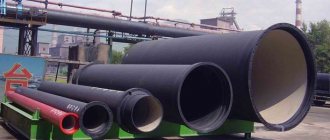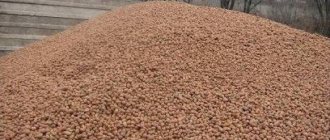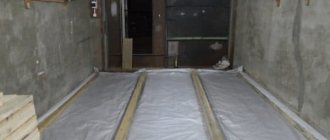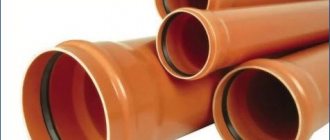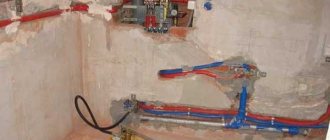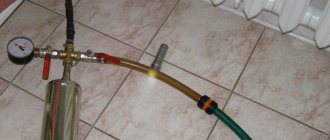How to properly insulate a sewer pipe
Many people have a question: “Do I need to insulate sewer pipes?” There are sources that claim that such an event is not necessary. This statement is justified by the fact that the drains have a temperature that completely prevents freezing.
Foam shell for pipe insulation
But it is not so. Very often, during the cold season, external sewage systems freeze, both in urban apartment buildings and in private country houses. The conclusion is obvious: something needs to be done.
Insulating a sewer pipe in the ground: methods
Particularly at risk of freezing are those segments of pipes that go outside the house and are located in close proximity to the surface of the earth. This factor must be taken into account at the stage of construction of the structure. But laying pipes below the freezing depth of the soil is very difficult if the value of this parameter exceeds one meter, and also if there is a high groundwater level. In this case, you cannot do without more expensive methods of insulating a sewer pipe in a private house. These include:
- use of insulating foam shell;
- insulation of external sewerage pipes using heating electrical cables;
- the use of heat-insulating structures of various types;
- combined options.
When choosing a method for insulating external sewer pipes, it is necessary to take into account the climatic zone in which the house is located and the method of laying the pipeline.
Climate zone
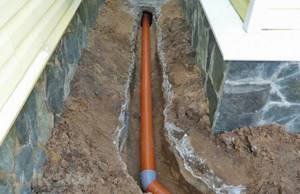
The sewer pipe was laid without insulation with rolled materials
It is not necessary to insulate pipes in the southern regions of our country. It is enough to simply lay them underground to the calculated depth, and then fill the pipeline with soil. It is often wrapped with thin insulation. But, as practice shows, such isolation is an unnecessary waste of money.
In northern regions, a heat-insulating structure must necessarily include a thick layer of insulation (minimum 10 cm) and a protective box.
Helpful advice! Before insulating a sewer pipe in the ground, do not be lazy and study as many types of thermal insulation materials as possible. On the market today you can find ones that are able to cope with low temperatures with a smaller thickness. And this saves effort and material resources.
Pipe laying method
When a pipeline is laid in the ground, its thermal insulation is carried out by filling the trench with expanded clay, asphalt or other material with similar properties.
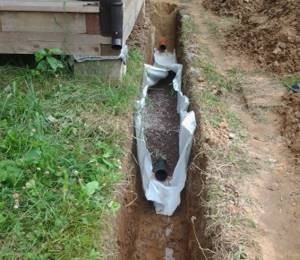
Insulation of a sewer pipe by backfilling a trench
Roll or slab types of thermal insulation are often used. But in the latter case it will be necessary to create external protection for them. It can be realized by creating a box of concrete blocks or bricks, which must be waterproofed. Only then will ice plugs from sewage not form in insulated sewer pipes in the winter, which will save the owner of a private house from unnecessary extra expenses.
Heating with heating cable
The use of heating cables, according to many experts, is the best way to protect against freezing. This applies to areas where the winter temperature is below -15˚C.
The installation procedure is also simple. The cable should be routed in or on top of the pipe. It is connected to the network using an RCD and a corresponding circuit breaker.

To obtain the best result, it is advisable to lay the cable in several rows or in a spiral. It is secured with aluminum tape. A layer of insulation must be installed on top of it.
Please pay attention! When heating plastic pipes, it is advisable to glue them with foil or aluminum tape. This will ensure the most even distribution of heat.
To heat the sewer line, 2 types of cable can be used - regular and self-regulating.
A regular or resistive cable will cost less, but it will consume more electricity. That is why it is worth considering using the second option.
A self-regulating cable consumes noticeably less electricity. During operation, it heats only those areas where the temperature has dropped below a certain value. After the area has warmed up, the power is turned off and no electricity is consumed.
External sewerage in a private house is a route for the movement of liquids and waste, and like any engineering system, it needs proper installation and insulation to prevent stagnation and freezing of water in the pipes.
Insulation of sewer pipes located in the soil freezing zone is a prerequisite. The purpose of pipe insulation is to protect the sewer system from freezing in the ground during frosty periods.
Installation of insulation for sewer lines in the ground
The insulation is installed when all the pipes have already been laid and connected to the sewerage system itself.
In this case, all pipes run at a slope of 1 centimeter per linear meter.
When installing insulation, you should pay special attention to ensure that there are no bare areas left, otherwise this whole procedure will be useless.
The beginning and end of the pipe and joints are also carefully processed. In such places, you can put several layers of insulation to be sure.
Otherwise, installation of insulation is very simple and takes little time.
Installation features
Having chosen the desired insulation, immediately read the instructions for it, since each of them has its own characteristics.
Thermal insulation methods
The choice of thermal insulation method is influenced by a number of factors:
- The location of housing in a certain climatic zone. In warm regions of the country, it is enough to maintain the slope angle and install sewer pipes in the ground at a convenient depth. In areas with a temperate climate, the sewer line is laid at a depth of 20–30 cm below the freezing point of the soil. Northern regions will require additional types of insulation due to permafrost.
- Use of insulating materials. This is caused by:
- the impossibility of installing a collector below the ground freezing level;
- presence of permafrost;
- increased level of groundwater, as a result of which it is necessary to lay sewer pipes in the ground above the non-freezing boundary of the soil;
- Geological factor - rocky soil, making it impossible to immerse the collector underground or swampy soil.
Insulation of a sewer pipe is carried out:
- Immersion below the freezing level of the soil.
- Construction of an overpass and a special box.
- Using thermal insulation materials.
Stages of insulation of sewerage in the ground
The first step is to prepare the trench. In this case, the depth should be 10 cm greater than planned in order to create a shock-absorbing cushion of compacted sand.
The external sewage system itself is assembled on the surface and insulated there.
But initially, the joints of communications are sealed with sealant in order to prevent the appearance of gaps. Next, waterproofing materials are laid, but if the material has its own waterproofing, this will not be required. Otherwise, it makes sense to use plastic film or foil.
Next comes the stage of thermal insulation itself. If expanded clay is used, then not only the communication pipes, but also the trench itself need protection from dampness.
The foam shell is fitted onto the pipes and secured with aluminum tape. To secure technical wool you will need construction tape. Both materials are placed with the moisture-proof layer facing outwards.
Installation features
When laying a sewer system, each method of insulating it has its own nuances:
- Trenches are usually dug 40 cm wider than the pipes being laid. When laying pipes to a depth of more than 1.5 m, it is necessary to increase the width of the trenches so that it is convenient to carry out installation. The greater the depth, the wider the trenches.
- Insulated sewerage can be laid to a depth of at least 50 cm. In this case, the trench is dug with a reserve: at least 5 cm or two thicknesses of insulation in depth and at least 60, not 40, centimeters in width.
- When using insulation that absorbs water, a waterproofing film is first laid out in the trenches. After laying and insulating the pipes, the waterproof film is overlapped and sealed with mounting tape.
- Rolled heat insulators are wrapped around the pipeline and tied with nylon twine, wire or mounting tape.
- Molded thermal insulation materials are placed on the pipes and secured with clamps.
- When insulating in several layers, it is important to ensure that the joints of the insulation in different layers do not coincide, but run apart.
- To install a heated sewer system in places where the cable is pulled in one thread, additional trench width is not required. But in areas where the electrical cable will be laid in a spiral around the pipeline assembly, the trench should be widened by at least 20 cm.
- Along the line of pulling the heating cable, aluminum tape is glued to the pipeline. Then fix the electrical cable and cover it with another layer of aluminum tape.
Note! When calculating trench parameters, the outer diameter of the pipes is taken into account in all cases.
Is insulation necessary?
In modern literature devoted to the peculiarities of laying sewer pipes with your own hands, the opinion is often expressed that insulating the sewer network is not at all necessary.
They say that the sewerage itself has a relatively high temperature, and is also constantly in motion - that is, the sewage system cannot freeze in any way.
Alas, all these theoretical calculations are in no way confirmed in practice - as soon as the thermometer goes “deeply minus”, the sewage, despite all its “warmth and mobility”, begins to freeze, first clogging the sewer pipe, and then (if it’s frosty) long enough and the temperature drops low enough) leading to a sewer burst.
So, in addition to the cessation of the functioning of the sewer system, which in itself is unpleasant, there is also a spill of sewage into the external environment.
Insulation for sewer pipes
Since we are talking about insulating the external sewer system in a private house, let’s consider how to insulate pipes with your own hands. The most important thing in the process of insulating external sewerage is the choice of material that will determine the installation features and provide a given level of reduction in heat loss.
It should be noted that sewer insulation, as a separate type, is a non-existent material. That is, there is no single solution, and in each case it is necessary to select insulation based on the individual characteristics of the pipeline.
Thermal insulation of sewer pipes is carried out by any of the thermal insulation materials on the market.
There are only two determining factors when choosing insulation:
- climate zone. The lower the winter temperature, the lower the thermal conductivity index the insulation should have;
- pipe laying method. The choice of pipe insulation depends on the depth to which the pipes are laid (below or above the freezing level). The technology for insulating external sewers using thermal insulation comes down to two methods: the pipe is wrapped with insulation in several layers or a box is built around it.
Which insulation for sewer pipes is better to choose?
A good building thermal insulator must meet a number of requirements:
- low thermal conductivity coefficient;
- ease of installation;
- resistance to various factors: moisture, biological activity, ultraviolet radiation, mechanical or chemical influences;
- tightness of insulation;
- resource of use;
- price.
Materials for external drain networks and their prices
Insulation for external sewerage should be chosen correctly, and the price in this case is an important factor
It is important to understand that the insulating coating laid in a well or septic tank will be the key to reliability
Watch the video
Of the most popular materials for external drainage systems, we can highlight:
- Styrofoam. It consists of small granules. This option does not require additional waterproofing. This building material is produced by sintering granules. This product is very easy to use, is environmentally friendly and lasts a long time.
- Mineral wool. It belongs to the traditional options and is characterized by low cost. However, it is not preferred for sewer mains. Mineral wool cakes over time, plus it has a high hydroscopicity rate. Insulation made from wet mineral wool completely loses all the necessary protective properties.
- Foamed polyethylene. This method of insulation for external sewerage is characterized by ease of installation. It is also not afraid of dampness; in such conditions, unlike the previous insulation, it will not lose its properties from getting wet. This type of insulation in rolls has a small thickness, so many layers must be wound onto pipelines for high-quality insulation. You can buy foamed polyethylene in the form of a canvas or in the form of ready-to-use covers of various sizes.
- Expanded clay. This method is preferable for external insulation. They simply fill the trench where the highway is located. Only expanded clay is allowed to be used in dry recesses, otherwise its protective properties are lost.
- Folgoizol. Produced in two types: SRF and FG. This building material is equipped with fiberglass, which is glued with plastic film. In the production of foil insulation, aluminum or corrugated foil and a bitumen-polymer binder layer are used. A special feature of this type is its very long service life in external communications.
- Foamed synthetic rubber. This is a flexible, closed-cell insulation material. It goes on sale in the form of sheets and pipes. Tubular casings can be used for pipelines of any volume. Recently, the popularity of foamed synthetic rubber has decreased.
- Expanded polystyrene. Made from suspension polystyrene. During the production process, a foamed material is obtained, consisting of granules securely welded together. The advantage of the material is its high rigidity.
- Penoplex. This is a foamed type that consists of a large number of granules. This option is called the most suitable because penoplex is able to withstand large mechanical loads. This property becomes very important in the current situation. It should be added to the above that penoplex, as an option for drain lines in the ground, can be used in conditions of high humidity.
- Isopon. Most often used as thermal insulation when laying domestic and industrial systems. Its main advantage is its strength and resistance to moisture. Laying isopon is very fast.
- Polyurethane foam. The peculiarity of this type is installation using a special installation, and this costs a lot of money.
- Extruded polystyrene. Has a cellular structure. Ideal for insulating pipelines that are subject to severe loads during operation.
- Basalt. It is made from basalt fibers, which are stitched with glass lines.
- Glass wool. It is characterized by high density. It is often used to insulate metal-plastic sewer pipes. During the thermal insulation process, it is necessary to use additional insulators that protect the insulation from negative environmental factors.
There are also other thermal insulation materials on the market that have certain differences. So, a popular option is considered to be insulation that has a foil layer. This layer reflects thermal energy, which improves the efficiency of insulation.
Speaking about options for drain lines in the ground, it is necessary to note their affordable cost.
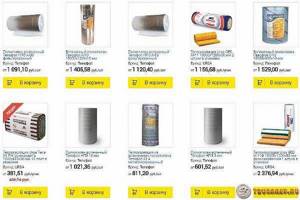
The exact price can be checked with managers when ordering. Also, when ordering, you can receive complete information about the selected product and its characteristics.
How should a pipe be insulated?
There are various ways to insulate sewer pipes, as well as various modern materials for this.
You can use “stockings” made of energyflex (foamed polyethylene), which can be stretched over a 110 pipe. The wall thickness of such insulation is about 1 cm. The thermal insulation effect here is provided by an air layer of air bubbles in a layer of foamed polyethylene. To be honest, such “insulation” in the ground practically does not work. The soil strongly compresses this foamed polyethylene, reducing the air gap to almost zero. Such “thermal insulation” is done, rather, to reassure the owner. Like, cheap and simple. In most cases, this is not a disaster, since, as I already said, up to 10 m the pipe does not need to be insulated at all.
Energoflex is a good insulation material, but only for interior work. Or when the pipe runs through an uninsulated basement. In order for such insulation to work in the ground, it is necessary, at a minimum, to protect the insulation layer from soil pressure. For example, insulate a pipe with a diameter of 110 mm with energyflex and lay it all in a pipe of a larger diameter, for example, 160 mm. Such a large pipe will serve as protection for the insulation, and the route can thus be routed over considerable distances.
Another quite workable option is to insulate the pipe with energyflex, and pour a “jacket” of coarse and medium-fraction crushed stone around the pipe. In this case, the additional insulation will be the air between the pebbles. That is why small crushed stone cannot be used, there is almost no air there. You need to put a geofabric on top of the crushed stone layer, and fill the entire route with regular soil on top. The geotextile will prevent the soil from spilling down and filling the gaps between the stones.
More modern materials can be used. For example, there is a special foam shell with a wall thickness of 5 cm. Or a shell made of extruded polyurethane foam, with a layer thickness of 3-5 cm. When burying a pipe in a foam shell, there is a risk of serious disruption of the slope - due to uneven pressing of the shell by soil. Since EPPU is much tougher, there is less such risk. But such a shell is more expensive.
You can also insulate a sewer pipe using a heating cable. This may be relevant in northern latitudes. In the middle zone this is unnecessary; it is better to use the insulation methods indicated above.
- What slope should the sewer pipe be laid at?
- what pipes should be used for excavation work,
- how to properly run a sewer line from the house to the septic tank - read here.
Heating with cable
Heating using cables is an effective way to protect sewer pipes from winter cold. For this purpose, wires with special insulation are used. The cable itself is divided into three main types:
- Self-regulating. It is particularly effective and safe. The cable automatically adjusts the resistance depending on the ambient temperature, which eliminates overheating or freezing of the system;
- Resistive. This type of cable is recommended for use in conjunction with thermostats. Otherwise, the system will quickly fail. Despite the need for operation with an additional device, resistive cable is used most often for heating sewers. This is due to its low cost;
- Zonal. The cable is used to heat only small sections of pipes. Most often it is used to heat network sections located in the basement.
How to insulate a sewer pipe? An electric heating cable can be attached to a pipe in several ways:
- One-sided straight;
- Double-sided straight;
- Winding the pipe in a spiral.
When using cables to heat sewer pipes, their location must be taken into account. If the networks are laid underground, then this method is sufficient to ensure normal operation of the system in winter cold.
How are sewer systems insulated in private houses if the pipes are located on or above the ground? With this arrangement, they are additionally insulated. It needs to be mounted in several layers.
The heating cable can also be laid inside the sewer pipe. This installation method is more labor-intensive. In addition, it is necessary to use wires with special insulation, which reliably protects against exposure to water, chemical and biological waste.
When using a cable, it is necessary to ensure uninterrupted power supply for its high-quality and reliable operation.
